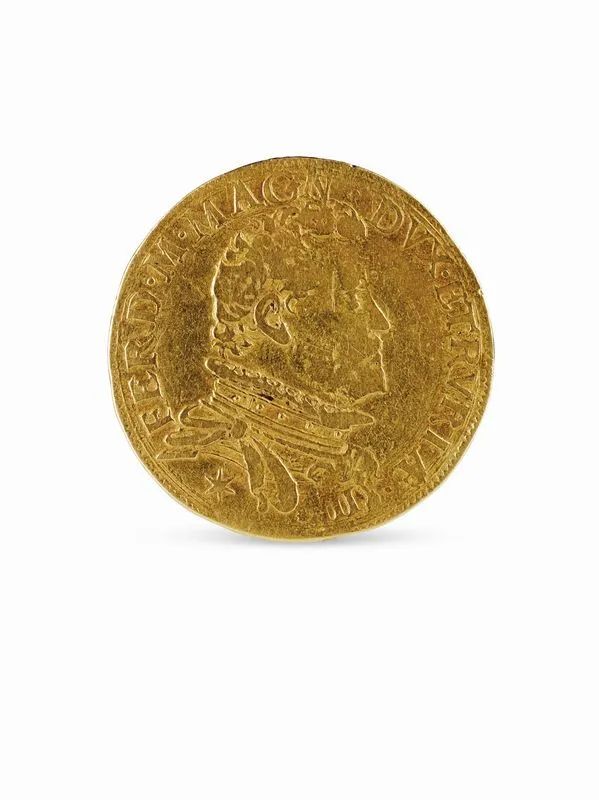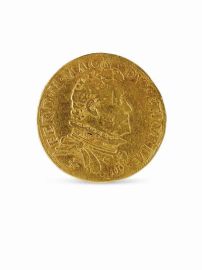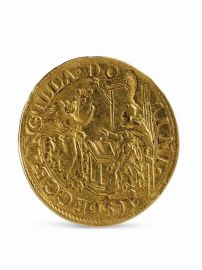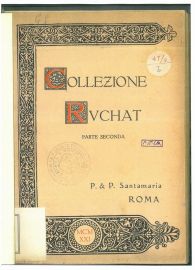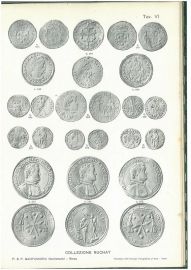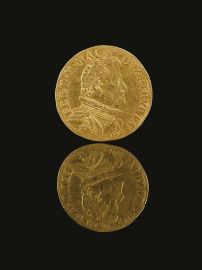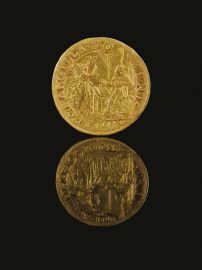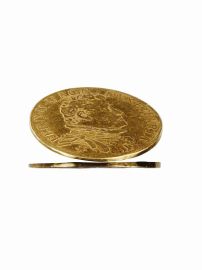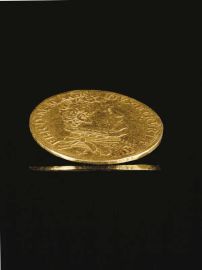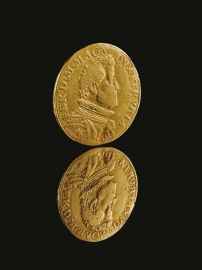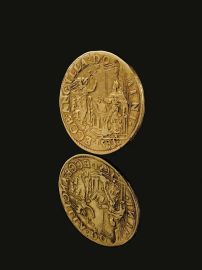FLORENCE, FERDINANDO I DE’ MEDICI, DOPPIA DA DUE O SCUDO QUADRUPLO, 1591
FLORENCE, FERDINANDO I DE’ MEDICI, DOPPIA DA DUE O SCUDO QUADRUPLO, 1591
22k gold, 13.20 gr., 30 mm.
The front of the coin shows the armoured bust of the Grand Duke facing right surrounded by the short inscription: FERDINAND DE MEDICI GRAND DUKE III OF TUSCANY. On the reverse of the coin the Annunciation, a topic very dear to the Grand Duke, is represented by two figures: a winged Archangel Gabriel, blessing and holding a long lily, symbol of purity, and the Virgin, shy and surprised by the sudden celestial revelation, sitting on a bench with an open book. The coin is surrounded by the inscription: I AM THE SERVANT OF THE LORD 1591
Provenance
P.& P. Santamaria, Rome 1921, Ruchat Collection (part II), lot 563. Previously in Ginori Conti Collection
Bibliography of references
C.N.I. (Corpus Nummorum Italicorum) vol. XII, Tuscany, Florence, A.A.V.V. Rome 1930, p. 314 no. 101
M.I.R. (Monete Italiane Regionali) vol. 9 (Florence) by A. Montagano, no. 208
A. Pucci, Le Monete della Zecca di Firenze, epoca Medicea, Ferdinando I (1587-1609) 2010, p. 54 no. 23b
Technical Description
Mint: Florence
Nominal Value: Coin Pair or Quadruple Scudo
Issuing Authority: Ferdinand I de’ Medici, Grand Duke of Tuscany (1587 – 1609)
Year of issue: 1591. Number of coins to be issued: 1,260, each weighting 13.504 gr.
Issuing Value: 38.8 Lire.
Engravers of coins: Michele Mazzafirri or Lorenzo della Neva
Metrological features: 22k gold, 13.20 gr., 30 mm.
Degree of rarity: extremely rare
Condition: beautiful
Front of the coin: FERD • M • MAGN • DVX • ETRURIÆ • III Armoured bust of the Grand Duke facing right
Reverse of the coin: ECCE • ANCILLA • DO MINI • The Annunciation. Exergue 1591
In 1587, at the age of thirty-eight, Ferdinand I succeeded to the throne of the Grand Duchy of Tuscany to his brother; he was the sixth son of the Grand Duke Cosimo I and of the Grand Duchess Eleanor of Toledo, daughter of the Spanish Viceroy of Naples. After becoming Grand Duke, he kept the position of cardinal untilhe was forced, for dynastic reasons, to renounce to it to marry the Princess Maria Christina of Lorraine. In many situations the behaviour of Ferdinand I was opposite to that of his brother and predecessor Francis I. Gentle and generous, he exerted his power with a mild-mannered attitude. In fact, he was always interested in the well-being of his people. He also restored the judicial system, reorganized corporations, duties and in particular the bureaucratic apparatus, and promoted a fiscal reform. He diverted part of the stream of the Arno river into a canal that greatly improved the connection between Florence and Pisa. From a military point of view, Ferdinand I sustained both Philip III of Spain in the Algerian campaign and the Holy Roman Empire against the Turks. He also promoted the formation of an efficient navy and repeatedly defeated the fleets of pirates and Turks. In the field of art, he carried on the great patronage of the Medici family: among the most important commissions, Ferdinand I commissioned, for example, to Buontalenti Forte Belvedere and to Giambologna the statue of his father, Cosimo I, that can be still admired today in Piazza della Signoria.

